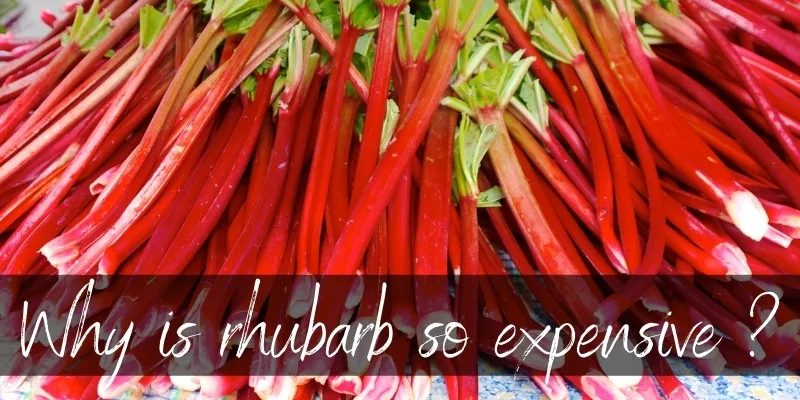Rhubarb (Rheum Rhabarbarum), one of the few perennial vegetables, is full of flavor and a great home garden choice. Today we have the opportunity to enjoy this attractive plant throughout the year. Like everything else, it comes with a price.
With beautiful, deep green, textured leaves, this large plant is pretty easy to grow and maintain but usually not so affordable in the stores. Accordingly, we can’t help but wonder why rhubarb is so expensive?

Why is rhubarb so expensive?
Rhubarb is expensive because there’s a limited amount that can grow each year, and it’s a spring-summer crop. If the weather is poor, an entire crop can be affected, leading to high prices.
It’s challenging to find the human resources to grow rhubarb out of season. And because of the limited crop sizes, it’s not surprising that this edible plant is higher in price during that period of the year.
Rhubarb is usually harvested during the spring and summer when we can enjoy rhubarb pies, sauce, crisp, baked goods, and much more. To make this plant available to consumers all year round, people utilize heated greenhouses to grow rhubarb in warm climates.
People have been growing plants in heated greenhouses since time immemorial. As an outcome, we have a forced rhubarb at our disposal all the seasons. Early forced growing comes from West Yorkshire, England, and the harvest is between December and the end of March.
We will explain what the forced rhubarb is and why it’s a necessary procedure in the next few lines.
Read also: What Goes With Rhubarb ?
What is forced rhubarb?
A few decades ago, West Yorkshire produced about 90% of the world’s forced rhubarb, and now this number had dropped considerably. The remaining Yorkshire growers still fight to gain EU protected status for forced rhubarb.
The famous area where the growers utilize this method is bordered by Leeds, Wakefield, and Bradford, and is called the Rhubarb Triangle. The winning combination that encourages the plant to grow and develop is to put the rhubarb in warm dark sheds.
Traditionally, rhubarb stalks are picked under candlelight in the sheds because soft light is not good enough for their development. This is how the remaining stalks continue to grow. By this technique, the rhubarb is harvested between December and the end of March.
Furthermore, it takes a minimum of two and a half years to produce rhubarb, but, applied correctly, this technique could significantly prolong the rhubarb’s lifespan. After the first harvest, everything else goes easier.
Bearing in mind all the care required to grow forced rhubarb to consume it throughout the year, it’s not surprising that this unique plant is so expensive in the stores.
Color and taste of rhubarb
If properly cared for and maintained, rhubarb grows back year after year. An herbaceous plant, rhubarb is very affordable, needs little care, very few pests bother it, and is very durable. Although technically a vegetable, rhubarb is treated in the kitchen as a fruit.

Its beautiful and attractive texture makes it the ideal addition to your garden. Its delicious taste makes it an indispensable part of most kitchens. There are many ways to enjoy its taste, from rhubarb pie and rhubarb crisp to strawberry-rhubarb preserves and rhubarb-onion chutney.
The outdoor rhubarb’s color goes from pale pink to deep maroon and is very sweet and full of flavor, similar to fruit.
However, forced rhubarb is much deeper in color and has a more delicate flavor. It’s costly to produce it because it requires patience, time, and labor force to lift it in the fields and then place it in the sheds.
Once harvested, the maintenance process is more straightforward. The hard work will definitely pay off – you will be able to enjoy your plant during all seasons.
Read Also: Swiss Chard VS Rhubarb
More about rhubarb
When it comes to harvesting, it’s vital to cut off the leaf and the stalk base because the leaves are highly poisonous with toxic oxalic acid levels.
Regarding storage, you can put the fresh rhubarb in a plastic bag and then in the refrigerator. This way, it can last up to two weeks. But, for more extended storage, it’s recommended to be frozen or canned. If you choose the second option and want to use your plant later, you should first wash it, trim it, and cut it into appropriate sizes. Only then your rhubarb is ready to be frozen.
And as we already mentioned above, not only can it be an excellent addition to the other dishes, but it also contributes to the beauty of your yard for years to come.

